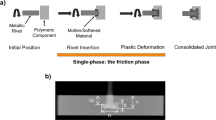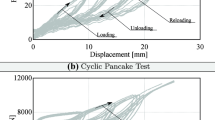Abstract
Numerical investigations were conducted on plane and axisymmetric convex joints of polycarbonate—aluminum and poly(methyl methacrylate)—aluminum interfaces to gain a better understanding of the stress state along the interface and also to aid an experimental study conducted on the same issue. Two-dimensional plane—stress investigations of convex joints revealed the successful elimination of the free-edge stress singulatities along the specimen width although stress singularities, along the thickness direction, persisted. A convex axisymmetric design, with the same material combination and joining angles, proves to be a better design in order to achieve an overall elimination of free-edge stress singularities of dissimilar materials and structures.
Similar content being viewed by others
References
Reedy, E.D. andGuess, T.R., “Comparison of Butt Tensile Strength Data With Interface Corner Stress Intensity Factor Prediction,”International Journal of Solids and Structures,30,2929–2936 (1993).
Williams, M.L., “Stress Singularities Resulting From Various Boundary Conditions in Angular Corners in Extension,”Journal of Applied Mechanics,19,526–528 (1952).
Xu, L.R., Kuai, H., andSengupta, S., “Dissimilar Material Joints With and Without Free-edge Stress Singularities: Part I. A Biologically Inspired Design,” EXPERIMENTAL MECHANICS,44 (6),608–615 (2004).
Bogy, D.B. “Two-Edge-bonded Elastic Wedges of Different Materials and Wedge Angles Under Surface Traction,”Journal of Applied Mechanics,38,377–386 (1971).
Munz, D. andYang, Y.Y. “Stress Near the Edge of Bonded Dissimilar Materials Described by Two Stress Intensity Factors,”International Journal of Fracture,60,169–177 (1993).
Xu, L.R. andRosakis, A.J., “Impact Failure Characteristics in Sand-wich Structures: Part II. Effects of Impact Speed and Interfacial Strength,”International Journal of Solids and Structures,39,4237–4248 (2002).
Barsoum, R.S., “Application of the Finite Element Iterative, Method to the Eigenvalue Problem of a Crack Between Dissimilar Media,”International Journal for Numerical Methods in Engineering,26,541–554 (1988).
Rice, J.R., “Elastic Fracture Mechanics Concepts for Interfacial Cracks,”Journal of Applied Mechanics,55,98–103 (1988).
Hutchinson, J.W. andSuo, Z., “Mixed Mode Cracking in Layered Materials,”Advances in Applied Mechanics,29,63–191 (1992).
Mattheck, C., 1998.Design in Nature: Learning from Trees, Springer-Verlag, New York.
Rabin, B.H., Williamson, R.L., Bruck, H.A., Wang, X-L., Watkins, T.R., Feng, Y-Z., andClarke, D.R., “Resdual Strains in an Al203-Ni Joint Bonded With a Composite Interlayer: Experimental Measurements and FEM Analyses,”Journal of the American Ceramics Society,81,1541–1549 (1998).
Author information
Authors and Affiliations
Rights and permissions
About this article
Cite this article
Xu, L.R., Sengupta, S. Dissimilar material joints with and without free-edge stress singularities: Part II. An integrated numerical analysis. Experimental Mechanics 44, 616–621 (2004). https://doi.org/10.1007/BF02428251
Received:
Accepted:
Issue Date:
DOI: https://doi.org/10.1007/BF02428251




